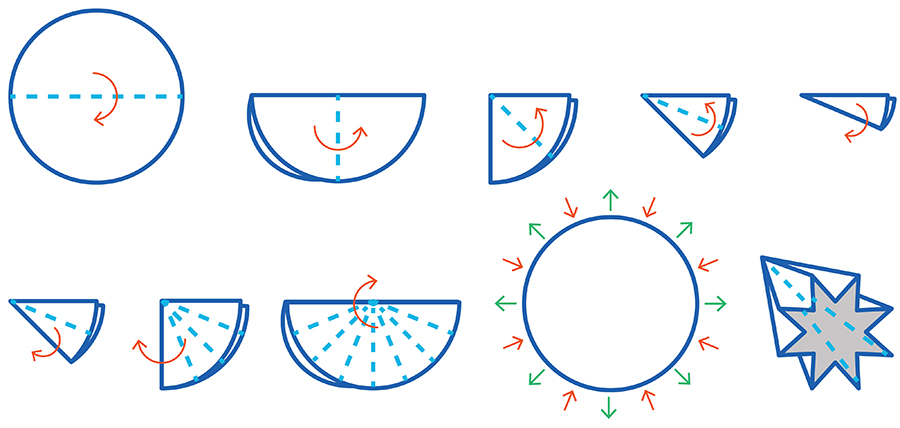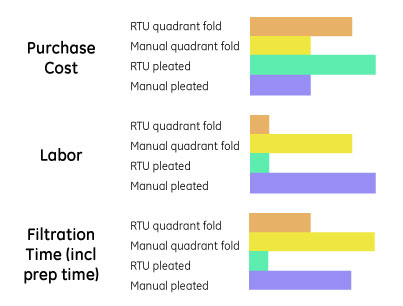Flow rates, filtration time, and overall project costs are all affected by your filter paper. Weigh up the benefits of choosing ready-to-use, pre-folded filter papers against manually folded quadrants or pleated filter papers.
The choice of filter papers can be overwhelming, and it can be difficult to decide on the most appropriate option for your application. With so many grades, formats, and materials available, how do you know which will be the most cost-effective, speedy, reliable, and consistent?
When you’re using a conical filter funnel, you’re also presented with several options for folding your filter paper. There are also ready-to-use, folded filter papers, which can save you some of that effort, help reduce the total time needed for filtration, and boost consistency and data reproducibility.
In this blog, I’ll look at some of the differences between pre-folded and flat filter papers for manual folding, talking through the benefits. I’ll also look at the differences between two common paper folding techniques. I hope this will help you to make an informed decision on what works best for your application, budget, and needs.
To fold or not to fold? Why fold filter paper.
If you’re going to use a conical funnel for your filtration, then you’ll be looking to fold a filter paper cone to fit into the funnel to maximize the effective filtration area and speed. There are two approaches you might consider taking: purchasing flat filter papers and folding them yourself, or buying ready-to-use filter papers pre-folded to the desired cone shape.
Manually folding flat filter papers is the tried-and-tested approach. But, while pre-folded filter papers might cost a little more upfront because of the increased production costs compared to flat papers, there are several benefits to your organization and the results you can generate. Pre-folded filter papers:
- Are convenient to use as they just need to be removed from the packaging and placed in the funnel.
- Require minimal prep time before filtration, reducing the overall filtration time.
- Have consistent performance that produces repeatable results.
- Minimize variation between users that might otherwise affect filtration efficiency (e.g. folding accuracy).
- Can result in an overall cost saving when taking labor into account.
Both the application and the scale of the filtration you perform might also influence your choice of approach. Quantitative analyses can benefit from the accuracy and reproducibility of using these pre-folded quadrant or pleated filter papers. Large operations that use multiple, perhaps hundreds of, filter papers each day, can benefit from the time-saving and reliability of ready-to-use filter papers.
Quadrant folded or pleated filter paper?
Okay, so you’ve decided whether pre-folded filter paper or manually folding filter papers works best for your application and organization. Now, what type of fold are you going to use?
Perhaps you’ve always used the quadrant fold. It’s a popular choice that’s simple and relatively quick to do manually. It essentially involves folding the paper in half twice to create a semicircle and then quarter-circle (Fig. 1A). But quadrant folds don’t provide the greatest surface area.
Pleating filter paper is another option that, while more time-consuming to do manually, provides a larger surface area for filtration than quadrant folding (Fig. 1B). Pleated filter paper (or fluted filter paper as it’s sometimes known) offers improved flow rate characteristics and a reduction in filtration time.
Figure 1 and our video on how to fold or pleat cellulose filter paper demonstrate these two folding methods. In either case, you have the option to minimize the preparation time and variation in folding with pre-pleated filter papers or ready-to-use quadrant folded filter papers.


Fig 1. The methods for manually producing quadrant folded filter papers (A) and pleated filter papers (B).
Making your decision on filter paper type and fold
The chart in Figure 2 compares ready-to-use and manually folded papers for both folded formats: quadrant and pleated paper (Fig 2). It includes the relative initial purchase cost, labor cost and time, and the total time for filtration (including preparation or folding time).
Fig 2. Comparison of key decision-making aspects of using pre-folded and manually folded filter papers.
You can see that there are both benefits and compromises for each filter paper type and fold, so it makes sense to consider the areas that will most affect your filtration method and application, and use them to identify the suitable option.
For example, if your labor costs are especially high, then perhaps cutting down on folding time and switching to pre-folded options will benefit you. On the other hand, if you need to reduce upfront costs and you don’t use a large number of filter papers each day, then manually folding your filter papers could be a more viable option.
Performance is another factor to consider. The ready-to-use formats enable you to be confident that the folds are consistent, whereas manual folding carries a risk of human error or variation in technique between individuals. In terms of fold, pleating offers improved filtration flow rates and so faster filtration times overall compared to quadrant folding.
Whatever type and fold you use in your filtration, I hope this has helped you identify the options that would work best with your application, budget, and needs. Don’t forget to also check out our other Lab Filtration blogs. To understand the different grades, materials, and considerations in filtration methods, our Filtration 101 blog series and Back to Basics articles on qualitative and quantitative papers are a good start.
If you’d like to discuss your filter paper options in more detail, contact GE Healthcare Life Sciences Support. Alternatively, try our filter selector tool to help guide you through finding a Whatman filter paper for your application.
